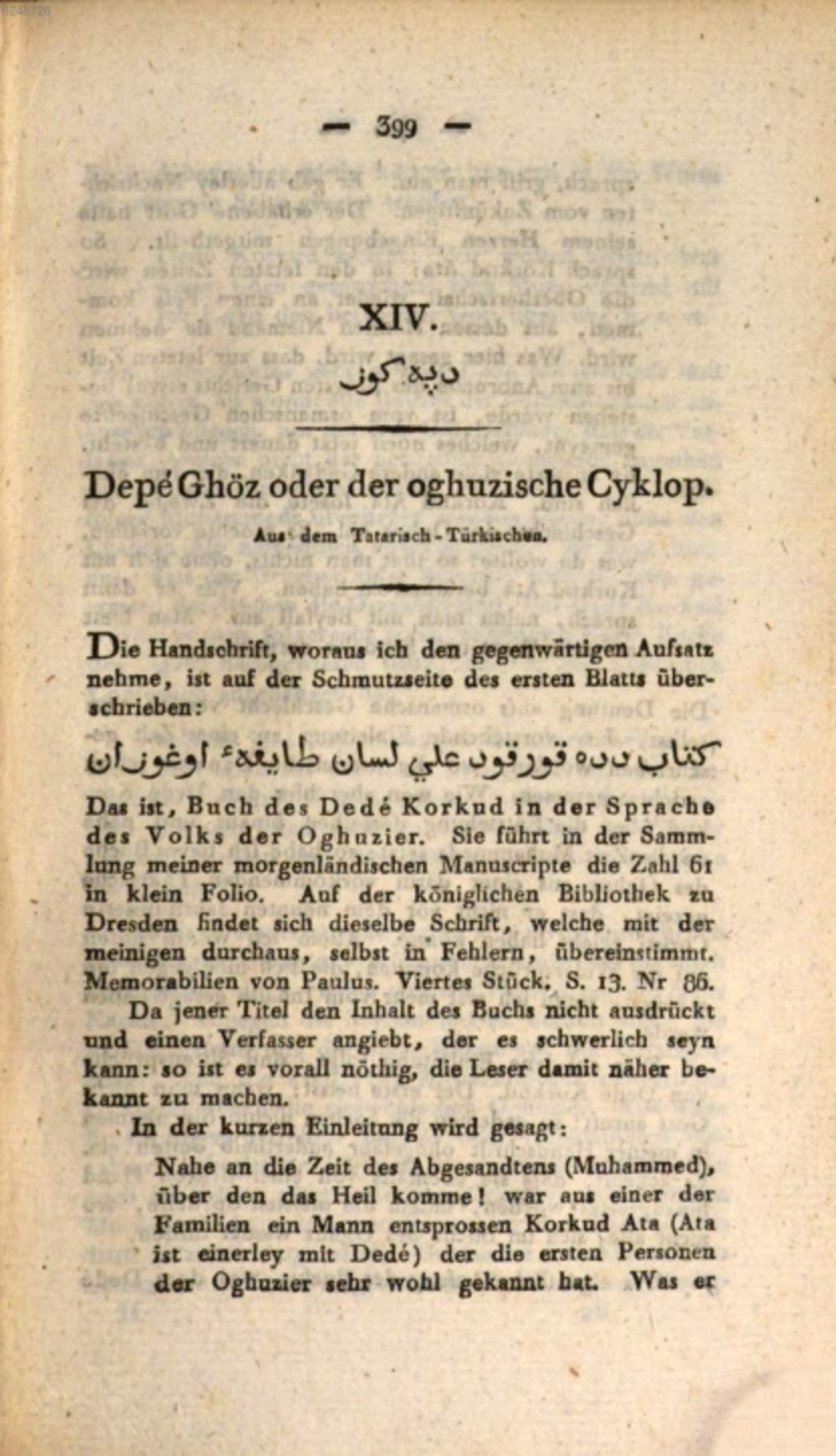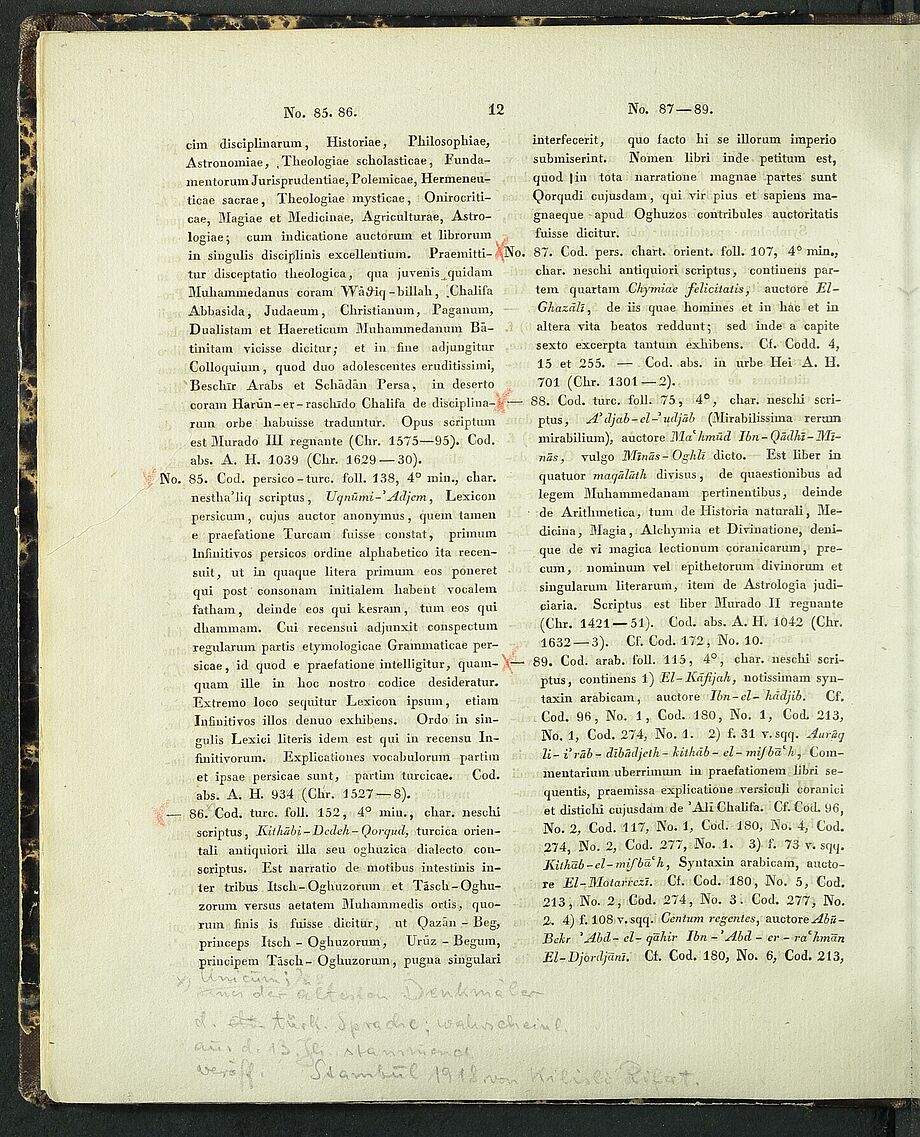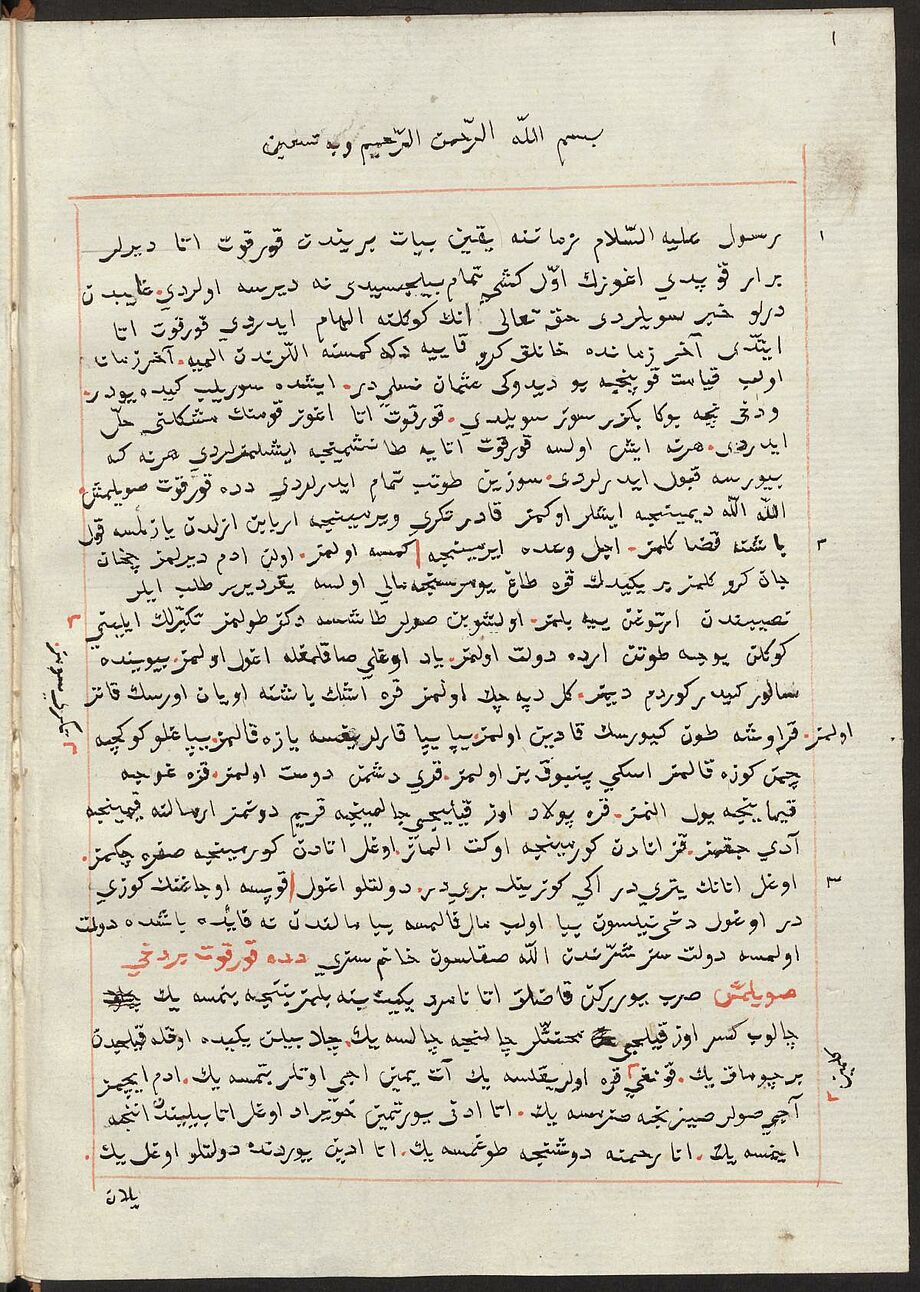Publication / Reception

In 1793 , an index of 135 of the then 352 oriental manuscripts in the Electoral Library, prepared by the Leipzig Arabist Johann Jakob Reiske (1716-1774), was published in the journal "Memorabilien". The Dede Korkut manuscript is described there (still under number 86) as follows (in German translation):
Life of Korkut in Oghuz dialect, as stated on the title page. On Corcud, the son of Bayezid II, see D'H[erbelot], [p.] 273. The Oghuz dialect is the same as the Turkish of the Ottoman family.
Apparently Reiske mistakenly identified the figure of Dede Korkut with the Ottoman prince and governor Korkud (1467-1513), whom he knew from the encyclopaedia "Bibliothèque orientale" by Barthélemy d'Herbelot (Paris 1697).
"Several scholars have already been allowed to make use of the manuscript treasures of the Dresden library abroad against a deposit. The publication of a part of them in an index, the correctness of which is guaranteed by the name of the author, can therefore really provide an opportunity for further use of them".
Thus wrote the editor of the journal, Heinrich Eberhard Gottlob Paulus, in a prefatory note to Reiske's directory (p. 2).
It took 20 years for the self-taught orientalist and book collector Heinrich Friedrich von Diez (1751-1817), who served as Prussian envoy in Constantinople from 1786 to 1790, to become aware of the Dede Korkut manuscript. Georg Wilhelm Sigismund Beigel (1753-1837), the senior librarian in Dresden at the time, who was himself concerned with oriental languages, allowed the manuscript to be loaned to Berlin in 1814, where Diez made an exact copy, which formed the basis for his further study of the Dede Korkut.

In 1815 Diez published the original text and a German translation of the story of the giant Depegös, whom he regarded as the model for the cyclops Polyphemos in Homer's Odyssey, under the title " Depé Ghöz oder der oghuzische Cyklop". Diez sent his translation hot off the press to Johann Wolfgang von Goethe, who praised it in 1816 as a "splendid work" and incorporated it into his "West-Eastern Divan".

In 1831, Heinrich Leberecht Fleischer (1801-1888), later an important professor of oriental languages in Leipzig, described the Dede-Korkut manuscript in the catalogue of the then total collection of 454 oriental manuscripts in the Royal Library, again under number 86, as follows (translated from Latin):
Turkish codex of 152 leaves in small quarto format, written in Neschi script [Naschī: common Arabic book script], Kithābi-Dedeh-Qorqud, composed in that older Eastern Turkish or Oghuz dialect. It is a narrative of the internal strife between the Inner and Outer Oghuz at the time of Muhammad, which is said to have ended with Kazan Beg, prince of the Inner Oghuz, killing Arus Beg, prince of the Outer Oghuz, in single combat, whereupon the latter submitted to the rule of the latter. The title of the book was chosen because large parts of the whole story deal with a certain Korkut, who is said to have been a pious and wise man of great influence among the Oghuz tribesmen.
In 1859, the Orientalist Theodor Nöldeke (1836-1930), then working at the Royal Library in Berlin, borrowed the manuscript in order to copy it (Nöldeke's estate at the University Library of Tübingen contains, as no. 44, a copy based on Dieze's copy, large parts of a German translation and notes on the Dresden original). However, a planned edition and complete translation were not published.
In 1892, the manuscript was lent to the German-Russian Turkologist Wassili Wladimirowitsch Bartold (1869-1930; maiden name Wilhelm Barthold) for copying at the Halle University Library. He edited in the journal Zapiski Vostočnago Otdelenija Russkago Archeologičeskago Obščestva in 1893 (1894), 1897/98 (1899), 1899 (1900 ) and 1902/03 (1904 ) the text of the first four stories together with a Russian translation and an extensive introduction on the Dresden manuscript and the book of Dede Korkut.
In 1916,Kilisli Mua‛llim Rif‛at (1876-1953) published a first complete edition with a Turkish translation based on the Berlin manuscript.
In 1922,Vasily Vladimirovich Bartold completed his Russian translation of the remaining 8 stories (not published until 1950 by Hamid Arasli [1902-1983] and Mämmädhüseyn Tähmasib [1907-1982] for ideological reasons).
In 1938,Orhan Șaid Gökyay (1902-1994) published the text in Latin transliteration based on Rif‛at.
In 1939,Hamid Arasli (1902-1983) published a Russian translation in Baku (Azerbaijan).
In 1950, a Turkmen translation was published by Mäti Kösäyev (1906-1974) (confiscated in 1951 for ideological reasons and republished in 1990 ).
In 1952,Ettore Rossi published an Italian translation and reproduction of the Vatican manuscript he had discovered.
In 1958,Muharrem Ergin provided the first complete edition of the Dresden manuscript and Joachim Hein the first complete German translation based on Rif‛at with explanatory notes.
In 1974, the first English translation was published by Geoffrey Lewis.
In 1988, the first complete Azerbaijani translation was published in Baku.
In 1995,Hanspeter Achmed Schmiede presented a German translation based on the Berlin manuscript.
In 1999, an international symposium was organised in Dresden on the occasion of a commemorative year proclaimed by the Republic of Azerbaijan and UNESCO to mark the 1300th anniversary of the Dede Korkud.
In 2000, Hanspeter Achmed Schmiede procured a critical edition of the Dresden manuscript in Latin transliteration with an imprint of the Dresden manuscript. The Dresden manuscript was photographed throughout and made accessible in the image database of the Deutsche Fotothek. A separate department for Dede Korkut research was founded at the Folklore Institute of the Azerbaijani Academy of Sciences.
In 2001 , Semih Tezcan and Hendrik Boeschoten edited the Dresden and Vatican manuscripts in Latin transliteration (review here).
In 2008 (Azerbaijani Cultural Year), Hendrik Boeschoten presented a German translation of the Dresden manuscript, which was digitised in the same year at the Dresden Digitisation Centre and made available worldwide via the Digital Collections of the SLUB. The original was exhibited in the exhibition "Azerbaijan. Land of Fire - History and Culture in the Caucasus" at the Japanische Palais in Dresden.
In 2015, on the occasion of the 200th anniversary of the publication of Heinrich Friedrich von Diez, an international conference on the topic of "Tolerance in the Epic 'Kitabi Dede Korkut' as one of the Literary Sources of Azerbaijani Multiculturalism" was held at SLUB. The docufictional music theatre piece "Dede Korkut - Die Kunde von Tepegöz" was premiered at the Festspielhaus Hellerau.
In 2018, the Dede Korkut stories were inscribed on the "Representative List of the Intangible Cultural Heritage of Humanity" by the UNESCO WorldHeritageCommission.
The "Book of Dede Korkut" has been considered a national epic in Turkey, Azerbaijan and Turkmenistan for around 80 years, and even children read it at school. Accordingly, there are numerous publications about this identity-creating literary monument and at the same time about the Dresden manuscript as the most complete textual witness. The UNESCO World Heritage Declaration and the new discovery of three more manuscripts in 2017 and 2018 (see chapter "Other manuscripts") brought a new impetus for scholarly and public reception. In Turkey alone, a total of 14 dissertations, 19 scholarly and 94 popular monographs, 10 textbooks, 101 articles and 52 scholarly essays were published in 2020 and 2021. There were 48 conferences and projects.
In October 2024, a diplomatic edition of the 12 stories according to the Dresden manuscript and the newly discovered 13th story with German translation, edited by Ergün Özsoy and Klaus Wolf, is to be published by De Gruyter.
